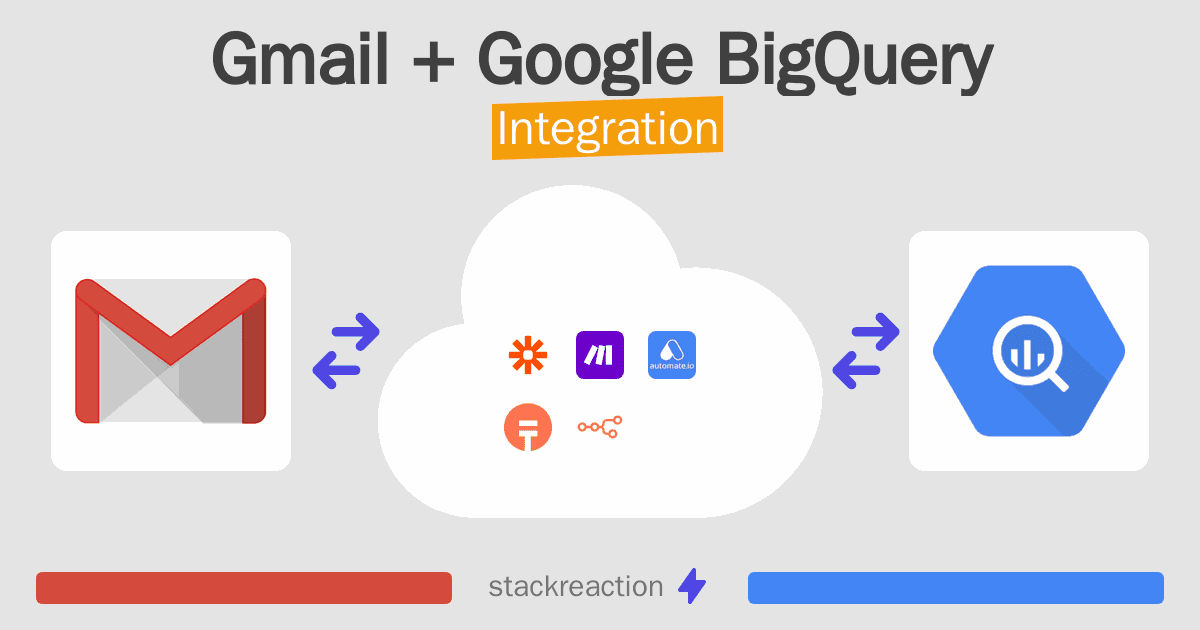How to connect Gmail and Google BigQuery
Popular Workflows for Gmail and Google BigQuery Integration
The integration of Gmail and Google BigQuery can unlock a host of benefits for businesses, including the ability to streamline workflows and automate repetitive tasks. Discover some popular workflows that are made possible through their integration.
- Save important messages or files to a spreadsheet or database
Workflow Automation Platforms supported by Gmail and Google BigQuery
Want to automate the exchange of data between Gmail and Google BigQuery without the hassle of coding? These workflow automation platforms make it possible. Explore this list to find the best fit for your business.
- Make.com. Make.com (Integromat) is a powerful automation tool that enables users to connect their favorite apps, services, and devices without any coding skills. With its unique features, users can automate even complex integrations easily and efficiently, saving time and effort. Integromat allows to connect apps and automate processes in a few clicks.
- Zapier. Zapier simplifies busy people's lives by automating web app data transfers, reducing tedious tasks, and allowing teams to collaborate effortlessly. With over 5,000 popular apps connected, it's never been easier to streamline your workflow.
- n8n.io. n8n is a workflow automation tool, which helps to connect different apps and tools between each other using it's open, fair-code model. n8n is available as an open-source (only fair-code use) software and as a cloud service.
- Integrately. Integrately helps to integrate your apps in 1 click using easy to set up automation templates. Live chat support and an impressive 10k+ customer base set it apart.
- Albato. Albato is the ultimate platform for automating all your business needs. With no coding required, you can connect any apps and streamline your workflows. Plus, their App Integrator allows you to easily add missing apps to their library. Albato Embedded is perfect for SaaS.
- Pricing Options
- FreemiumFree Trial
- Starting From
- 10$/month
- Pricing Options
- FreemiumFree Trial
- Starting From
- 30$/month
- Pricing Options
- FreemiumFree Trial
- Starting From
- 20€/month
- Pricing Options
- FreemiumFree Trial
- Starting From
- 30$/month
- Pricing Options
- FreemiumFree Trial
- Starting From
- 16$/month
Gmail and Google BigQuery Integration Price
When it comes to optimizing your workflow and streamlining tasks, integrating Gmail and Google BigQuery can be seamlessly achieved using no-code or low-code automation tools. However, it is crucial to understand the pricing aspects.
For those seeking pricing information on automation services that support Gmail and Google BigQuery integration, we have collected and organized the data for you. Check out our table below for details based on 100, 1K, 10K and 100K basic automations per month.
A basic automation is a scenario that comprises of a trigger and a single action. An example of this is automatically sending an email every time someone fills out a form.
| Automation Platform | 100 | 1K | 10K | 100K |
|---|---|---|---|---|
Volume: 100 Plan: Free $0 Volume: 1K Plan: Core $10.59 Volume: 10K Plan: Core $18.82 Volume: 100K Plan: Core $214.31 | $0 Free | $10.59 Core | $18.82 Core | $214.31 Core |
Volume: 100 Plan: Free $0 Volume: 1K Plan: Starter $58.5 Volume: 10K Plan: Professional $193.5 Volume: 100K Plan: Professional $733.5 | $0 Free | $58.5 Starter | $193.5 Professional | $733.5 Professional |
Volume: 100 Plan: Starter $20 Volume: 1K Plan: Starter $20 Volume: 10K Plan: Pro $50 Volume: 100K Plan: | $20 Starter | $20 Starter | $50 Pro | |
Volume: 100 Plan: Starter $29.99 Volume: 1K Plan: Starter $29.99 Volume: 10K Plan: Professional $49 Volume: 100K Plan: Business $299 | $29.99 Starter | $29.99 Starter | $49 Professional | $299 Business |
Volume: 100 Plan: Free $0 Volume: 1K Plan: Basic $19 Volume: 10K Plan: Pro $130 Volume: 100K Plan: | $0 Free | $19 Basic | $130 Pro |
Triggers and Actions supported by Gmail and Google BigQuery
Integrating Gmail and Google BigQuery involves identifying an automation that aligns with your business request.
Automations are workflows that link your applications to fully automate repetitive tasks. A Trigger serves as the initiating event of an Automation, while an Action denotes the event executed by the Automation.
We have carefully collected all the available Triggers and Actions from different Workflow Automation Platforms so that you can evaluate the integration possibilities and make an informed decision on how to integrate Gmail and Google BigQuery.
When this happens
Select a Trigger
Do this
Select an Action
How to setup Gmail and Google BigQuery integration
Step 1: Use a Workflow Automation Service that is compatible with both Gmail and Google BigQuery. Choose automation platform
60 seconds
60 secondsStep 2: Enable authentication for both Gmail and Google BigQuery on the chosen automation platform
60 seconds
60 secondsStep 3: Pick a suitable Trigger for Gmail that will kickstart your automation workflow. Explore Triggers
15 seconds
15 secondsStep 4: Choose a resulting Action for Google BigQuery. Explore Actions
15 seconds
15 secondsStep 5: Set up the data exchange between Gmail and Google BigQuery and configure the parameters to meet your requirements.
120 seconds
120 secondsStep 6: Complete your integration by testing and publishing it. You're all set!
More integrations to Gmail
Explore the list of other popular Gmail integrations. Gmail Integrations
More integrations to Google BigQuery
Take a look at the other popular Google BigQuery integrations that are available. Google BigQuery Integrations
Gmail and Google BigQuery integration Diagram

Frequently Asked Questions
Does Gmail integrate with Google BigQuery?
- You can connect Gmail and Google BigQuery automatically using no-code Workflow Automation Tool. Use Make.com, Zapier, n8n.io, Integrately or Albato to link Gmail and Google BigQuery.
Can you Integrate Gmail and Google BigQuery for free?
- Yes, you can use the free plan of Make.com, Zapier or Integrately to connect Gmail to Google BigQuery for free, albeit with some limitations. You can use open source workflow automation tool n8n.io to self-host your integration script between Gmail and Google BigQuery.

